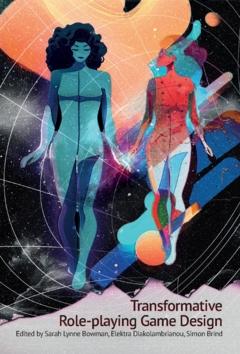About the book
This textbook describes theory and practice in analog role-playing game (RPG) design that encourage specific transformative impacts in participants, including tabletop, live action role-playing (larp), and Nordic and American freeform. We describe three types of transformative RPGs: transformative leisure, therapeutic, and educational. We present our model of nano-game design, offering recommendations for designing transformative goals; framing activities such as workshops and debriefs; narrative and culture design.
This interdisciplinary book highlights theories from role-playing game studies, peace and conflict studies, psychology, social psychology, sociology, counseling, anthropology, pedagogy, and several other fields. Key concepts include bleed, alibi, RPGs as transformational containers, immersion, identity, transfer, ritual, psychotherapeutic techniques, group theories, and educational theories. We emphasize psychological safety before, during, and after games, as well as strategies for cultivating transformational communities. Key topics include working with specific populations; crisis management; sensitive content and representation.
Then, we discuss working with myth, symbolism, and ritual, narrative, and postmodern magic as methods for transforming the stories of our lives. We cover forms of culture within and around RPGs, as well working with conflict in scenarios related to politics, culture, gender, sexuality, race, and ethnicity. We share thoughts around the use of RPGs to foster activism, advocacy, inclusion, and accessibility.
Finally, we offer considerations for researchers studying transformative role-playing games, including academic argument, structure, theory, method, data collection, ethics, and other considerations. We introduce key methods, including Research through Design, ethnography, and qualitative and quantitative data analysis. The book closes with a summary of evidence-based research available on the cognitive, affective, and behavioral effects of role-playing games.
Sarah Lynne Bowman, Elektra Diakolambrianou, and Simon Brind, editors
Table of Contents:
"Preface" by Sarah Lynne Bowman, Elektra Diakolambrianou, and Simon Brind
"Chapter 1: A Brief Introduction to Role-playing Games and Cousin Activities" by Sarah Lynne Bowman, Elektra Diakolambrianou, Angie Bandhoesingh, Guus van Tilborg, Alessandro Giovannucci, and Taisto Suominen
"Chapter 2: Transformative Role-playing Games: Types, Purposes, and Features" by Sarah Lynne Bowman, Elektra Diakolambrianou, Kjell Hedgard Hugaas, and Josefin Westborg
"Chapter 3: Theory, Key Concepts, and Inspirational Materials" by Elektra Diakolambrianou, Sarah Lynne Bowman, Simon Brind, Josefin Westborg, and Kjell Hedgard Hugaas
"Chapter 4: Practice: Designing for Transformative Goals" by Sarah Lynne Bowman, Simon Brind, Alessandro Giovannucci, Kjell Hedgard Hugaas, and Josefin Westborg
"Chapter 5: Safety and Community Container Setting" by Sarah Lynne Bowman, Elektra Diakolambrianou, Josephine Baird, Angie Bandhoesingh, Josefin Westborg, and Kjell Hedgard Hugaas
"Chapter 6: Myth, Symbolism, Ritual, Magic, Narrative, Culture, and Conflict" by Sarah Lynne Bowman, Simon Brind, Elektra Diakolambrianou, Kjell Hedgard Hugaas, Guus Quinten van Tilborg, Josephine Baird, and Alessandro Giovannucci
"Chapter 7: Research in Transformative Game Design" by Sarah Lynne Bowman, Josephine Baird, Kjell Hedgard Hugaas, Elektra Diakolambrianou, and Taisto Suominen
Information
Editor-in-chief
Sarah Lynne Bowman
General editor
Elektra Diakolambrianou
General editor
Simon Brind
Author
Elektra Diakolambrianou
Original publication year
2025Editions

- ISBN
- 9789151323015
- Pages
- 316
- Measurements
- 165 mm ✕ 242 mm
- Weight
- 746 g
Delivery time: 5-7 workdays within Sweden, rest of the world up to 14 workdays

